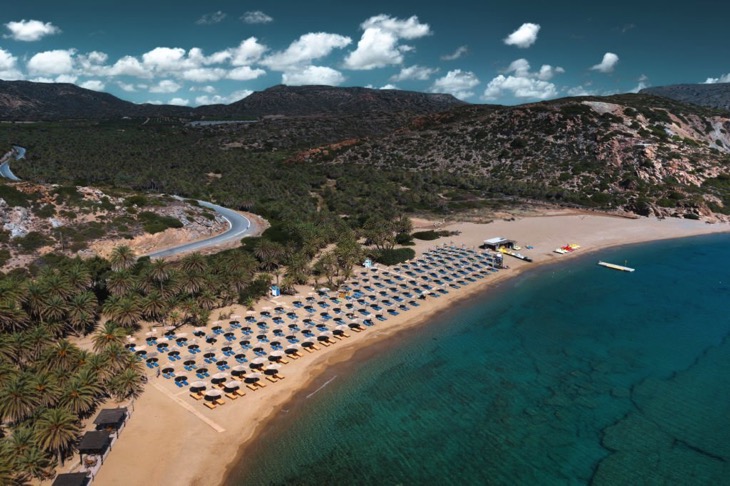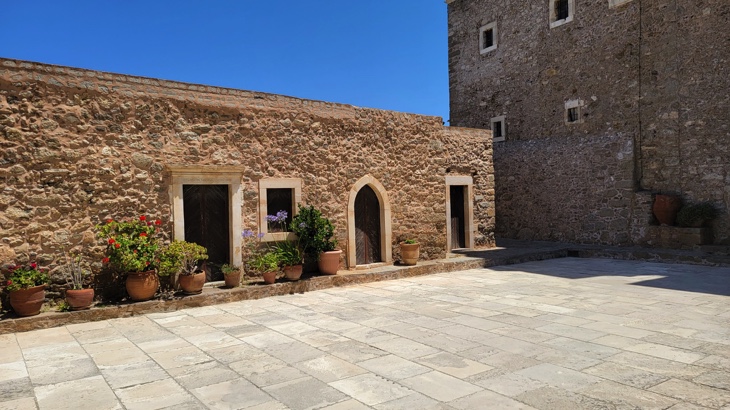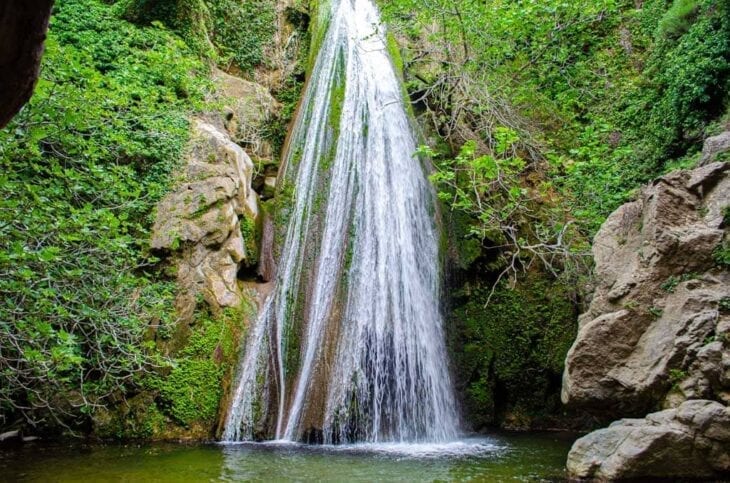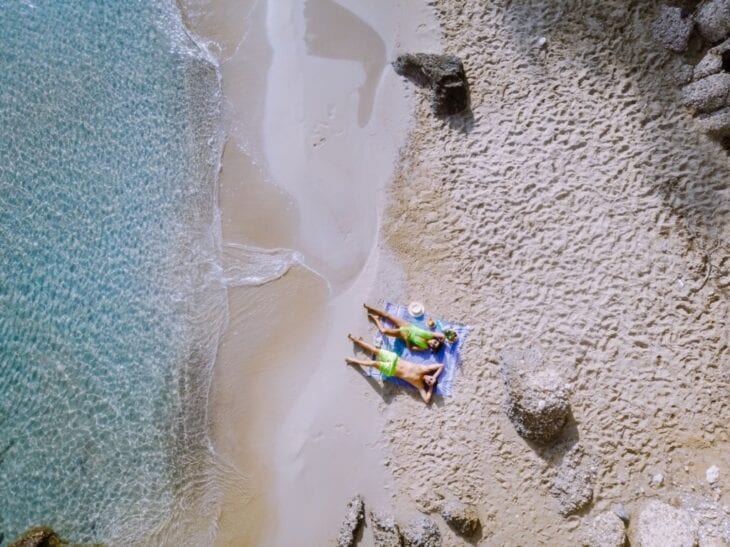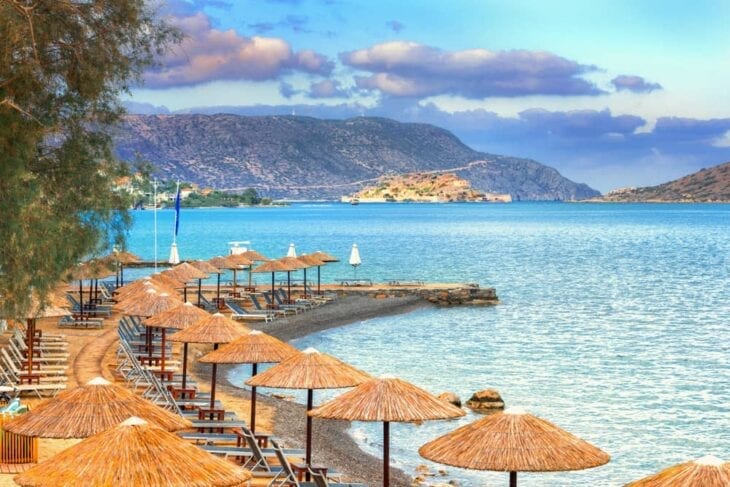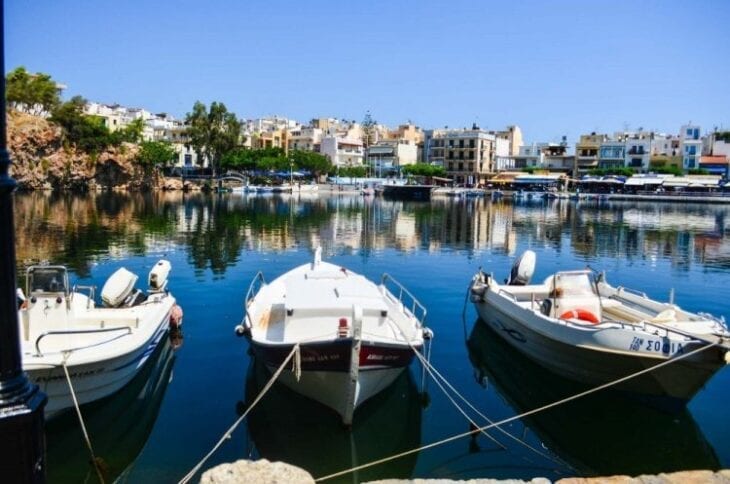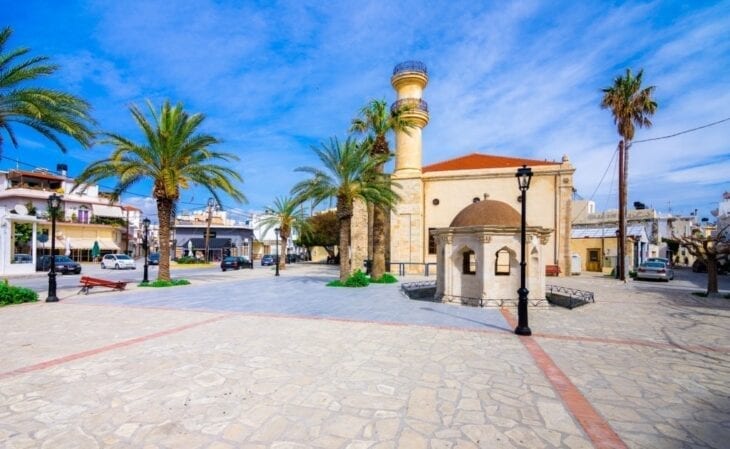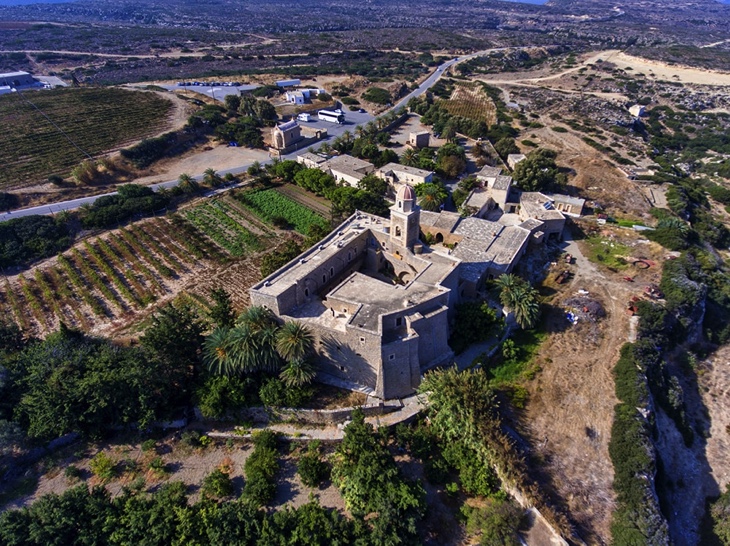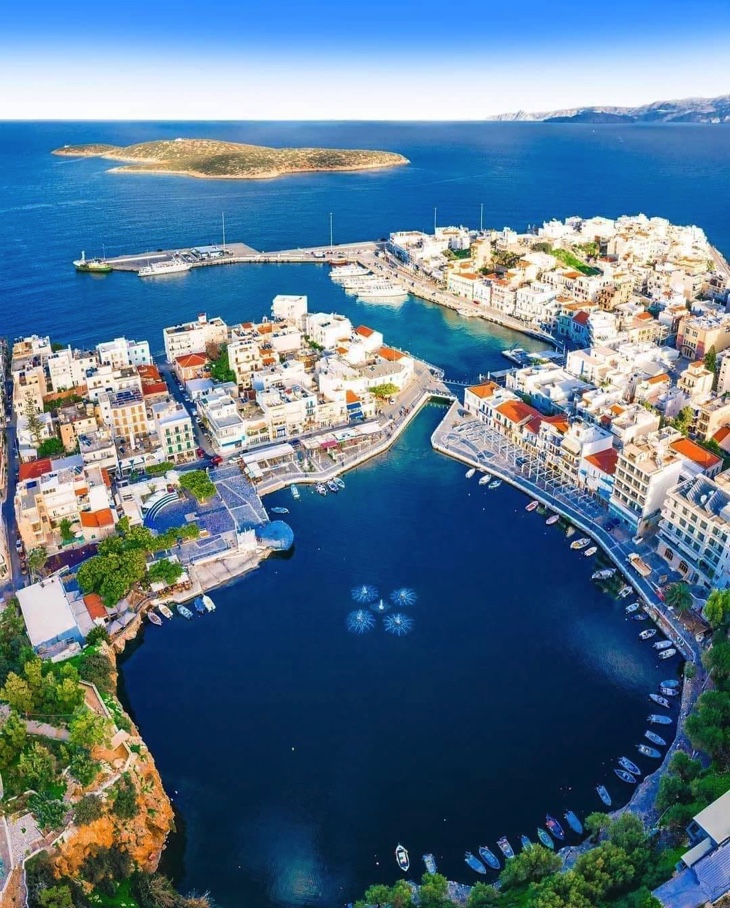East Crete: Things to do, Landmarks, Travel Guide and Car Rental

East Crete is a region in the easternmost part of the island of Crete, Greece. It is between the Ida Mountains in the west and the Dikti Mountains in the east. This region has a rich history dating back to the Minoan civilisation, one of the earliest advanced civilisations in Europe, which flourished from 2700 BC to 1420 BC. The Minoans were an advanced civilisation that developed an urban culture centred around major palace complexes like those found at Knossos, Malia, Zakros, and Palaikastro in eastern Crete. Their daily lives revolved around these palace centres, which served as administrative hubs, religious sanctuaries, and craft production centres.
East Crete is prominent in the economy due to its rich archaeological heritage, natural landscapes, and thriving tourism industry. The region has numerous archaeological sites, including the Minoan palace of Zakros, the ancient town of Gournia, and the Minoan settlement of Palaikastro, which attract history lovers and archaeologists worldwide. East Crete is known for its beautiful beaches, such as the famous palm beach of Vai, and its traditional villages, like Sitia and Kato Zakros, which offer visitors an authentic taste of Cretan life. The climate in East Crete is predominantly Mediterranean, characterised by hot, dry summers and mild, rainy winters. The geography of East Crete is diverse, with rugged mountains, arid terrain, and limited freshwater sources, except for a few springs and the Aposelemis reservoir near Sitia.
East Crete offers a variety of tours and activities for visitors, including archaeological site visits, hiking in gorges like the Richtis Gorge and the Zakros Gorge, exploring traditional villages, and enjoying water sports and beach activities. The region has a well-developed tourism infrastructure catering to various interests and preferences. East Crete has numerous historical structures, including ancient palaces, monasteries, churches, and traditional Cretan houses. East Crete attracts many visitors annually, drawn by its historical significance, natural beauty, and unique cultural experiences.
What are the best things to do in East Crete?
Listed below are the best things to do in East Crete:
- Vai Beach: Vai Beach, known as the Palm Forest, is at Epar.Od. Monis Toplous – Vai, Toplou 723 00, Greece, on the eastern coast of Crete, 25 kilometres (15 miles) east of Sitia and 94 kilometres (58 miles) east of Agios Nikolaos town. It is the largest natural palm tree forest in Europe, consisting of over 5,000 palm trees that stretch along the sandy beach and create a tropical paradise-like setting. Visitors can swim and sunbathe on the soft sandy beach, explore the palm tree forest, and enjoy the various amenities such as snack bars and coffee places located on the beach. There is no admission cost to visit Vai Beach, as it is a public beach. Visitors must pay for parking or other services if required.

- Toplou Monastery: The Toplou Monastery, 10 kilometres (6.2 miles) east of Sitia, is a 15th-century fortified monastery that stands as one of Crete’s most historic and significant monasteries. Its architecture, with sturdy walls resembling a fortress, reflects the need for protection against pirate attacks in the past. Visitors can admire the monastery’s beautiful icons and explore the museum, which houses many worthy objects, such as an 18th-century icon by Ioannis Kornaros depicting 61 miniature scenes. The monastery is known for producing excellent organic products like wine, olive oil, and thyme honey, which can be purchased on-site. Guided tours to Toplou Monastery allow visitors to learn about winemaking and taste the monastery’s wines paired with traditional Cretan delicacies.

- Zakros: Zakros is the site of an ancient Minoan palace and town, considered one of the four major palaces of the Minoan civilisation on Crete. The well-preserved ruins, excavated by archaeologist N. Platon in 1961, provide a fascinating glimpse into the advanced Minoan culture that thrived here over 3,500 years ago. Visitors can explore the remains of the palace, including the west wing dedicated to religious ceremonies, the central kitchen, and the royal bedrooms where treasures were discovered. A unique feature is the cistern room, which has a circular cistern still filled with water. The ruins also reveal Zakros‘ importance as a trade centre, with evidence of connections to Egypt and Syria.
- Richtis Gorge: The Richtis Gorge, located between Agios Nikolaos and Sitia, is a spectacular natural wonder offering a 3-kilometre (1.8-mile) hiking trail through a narrow ravine. The gorge has enough water flowing through it, which is utilised by locals. Visitors to Richtis Gorge can go on the hiking trail, which starts just outside the village of Exo Mouliana and ends at the beautiful beach, with an elevation of 350 meters (1,148 feet). Hikers can admire the rugged beauty of the gorge’s walls and the refreshing streams, making it a popular destination for nature lovers and adventure seekers.

- Lassithi Plateau: The Lassithi Plateau is a vast, fertile plateau surrounded by mountains in central Crete, offering visitors a unique blend of natural beauty, mythology, and history, at an altitude of 850 meters (0.5 miles). The plateau is known for its traditional windmills, once used to pump water for crops, and its villages like Tzermiado and Agios Georgios, where visitors can explore the Peasant Museum. According to Greek mythology, the Diktaion Cave on the plateau is the birthplace of Zeus, making it a site of great significance. Visitors can hike to the cave and admire the surrounding mountains of Selena and Afendis Hristos, as well as landscapes of orchards, fields, and sheep grazing.
What are the best beaches in East Crete?
Listed below are the best beaches in East Crete:
- Vai Beach: Vai Beach, known as the Palm Forest, is at Epar.Od. Monis Toplous – Vai, Toplou 723 00, Greece, on the eastern coast of Crete, 25 kilometres (15 miles) east of Sitia and 94 kilometres (58 miles) east of Agios Nikolaos town. It is the largest natural palm tree forest in Europe, consisting of over 5,000 palm trees that stretch along the sandy beach and create a tropical paradise-like setting. Visitors can swim and sunbathe on the soft sandy beach, explore the palm tree forest, and enjoy the various amenities such as snack bars and coffee places located on the beach. There is no admission cost to visit Vai Beach, as it is a public beach. Visitors must pay for parking or other services if required. Vai Beach is considered one of the best Crete Beaches to visit.
- Itanos Beach: Itanos Beach is in the ancient town of Itanos or Erimoupolis, 2 kilometres (1.2 miles) north of the famous Vai beach. This hidden gem offers a unique snorkelling experience, where visitors can swim in clear waters and explore the ancient ruins beneath the surface. The beach has soft pebbles and deep blue transparent waters, perfect for a relaxing swim. Visitors can find the beautiful sandy beach of Erimoupoli to the left, providing a contrasting experience. Itanos Beach is ideal for travellers wanting to experience the area’s rich history.
- Voulisma Beach: Voulisma, known as Golden Beach, is a famous and well-organized beach located on the coast of the small village of Istro, a few kilometres from Agios Nikolaos. This scenic beach features fine golden sand and blue waves, making it a popular destination for locals and visitors. Voulisma is perfect for families with children enjoying a fun-filled day of swimming and building sandcastles. The beach offers a range of amenities, including sunbeds, umbrellas, and a beach bar-tavern, ensuring visitors have everything they need for a comfortable and enjoyable experience.

- Xerokampos Beaches: The southeastern coast of Crete is home to the Xerokampos beaches, known for their quiet and family-friendly atmosphere. These beaches offer a peaceful escape from the crowds, with soft white sand, turquoise waters, and rock formations that create a beautiful landscape. Visitors can rent sunbeds and umbrellas to soak up the sun or explore the nearby tavernas and beach bars for refreshments. The shallow waters make Xerokampos an ideal destination for families with children who can safely splash and play in the gentle waves.
- Elounda Beach: Elounda Beach, opposite the historic Spinalonga Island, is one of Crete’s most popular and beautiful beaches. This well-organized beach offers crystal-clear waters, soft sand, and a range of amenities, including sunbeds, umbrellas, and water sports facilities. Visitors can enjoy a refreshing swim in the turquoise waters or simply relax on the beach and soak up the views of Spinalonga Castle. A mini-trip to the island is recommended, allowing visitors to explore its rich history and fortifications from the Ottoman and Venetian periods.

What are the best restaurants in East Crete?
Listed below are the best restaurants in East Crete:
- Pelagos Seaside Restaurant (Agios Nikolaos): Pelagos is a bohemian-style restaurant in Agios Nikolaos. Its romantic patio setting, adorned with wicker lanterns and potted herbs, creates a cosy and inviting atmosphere. The menu showcases innovative takes on Cretan cuisine, with standout dishes like slow-cooked octopus served over creamy fava bean puree and light vegetable fritters accompanied by tangy Greek yoghurt dip. Pelagos is highly popular among locals and visitors for its relaxed ambience and fresh, flavorful seafood dishes. Reservations are recommended to secure a table at this sought-after establishment. Plelagos Seaside Restaurant is considered one of the 10 Best Restaurants in Crete.
- Ferryman Taverna (Elounda): Ferryman Taverna offers a fine dining experience with beautiful views of the bay and the island of Spinalonga. The taverna’s menu features creative Mediterranean dishes crafted with locally sourced ingredients, such as the signature kleftiko lamb and seafood paella. The taverna attracts tourists and celebrities who can taste the delicious cuisine and enjoy the beautiful vistas. Ferryman Taverna is a must-visit destination for those seeking a memorable culinary adventure.
- Karnagio (Agios Nikolaos): Karnagio is a lively and affordable restaurant located on the lakefront of Voulismeni in Agios Nikolaos. This local hangout prides itself on showcasing the best of Cretan produce, including olive oil, sea salt, and honey, in its dishes. The menu features traditional favourites like Dakos (barley rusks topped with tomatoes and feta), seafood pasta, and sizzling meat skewers with authentic flavours. Karnagio’s atmosphere, friendly service, and commitment to using locally sourced ingredients have made it a popular spot among locals and visitors.
What are the best hotels in East Crete?
Listed below are the best hotels in East Crete:
- Blue Palace: Blue Palace is on a private peninsula in Elounda, in northeast West Crete, overlooking the island of Spinalonga. The hotel is ranked among the top luxury resorts in Greece and the Mediterranean and is known for its service, architecture, and world-class amenities. This high-end resort rate starts from €500 ($541.00, £434.50) to €1000 ($1,082, £869) per night during peak season. Guests can enjoy the private beach, multiple pools, an award-winning spa, several restaurants, kids’ clubs, water sports, tennis courts, and more, ensuring a truly unforgettable experience.
- Daios Cove Luxury Resort & Villas: Daios Cove Luxury Resort & Villas is a new addition to Crete’s luxury hospitality scene. It has received recognition for its offerings in the Agios Nikolaos area. This beachfront resort features a private sandy cove, sea-water infinity pools that blend with the azure waters, and a spa that promises ultimate relaxation. Families can enjoy the dedicated kids’ facilities, while couples can retreat to the privacy of their villa with a private pool at a price range of €300 ($324.60, £260.70) to €600 ($649.20, £521.40) per night.
- St. Nicolas Bay Resort Hotel & Villas: St. Nicolas Bay Resort Hotel & Villas is a long-standing luxury resort known for its service and top-notch facilities in the heart of Agios Nikolaos town. This beachfront property has multiple pools, a rejuvenating spa, and fine-dining restaurants that cater to every culinary desire. Guests can choose to stay in one of the villas, each with its private pool, at a price range of €200 ($216.40, £173.80) to €400 ($432.80, £347.60) per night. St. Nicolas Bay Resort Hotel & Villas offers an unforgettable luxury experience in East Crete.
What are the attractions in East Crete?
Listed below are the attractions in East Crete:
- Agios Nikolaos: Agios Nikolaos is a coastal town in eastern Crete, built around Voulismeni Lake. This small lake is connected to the sea by a narrow inlet, creating a unique and scenic setting. Visitors can stroll along the lake’s shores, lined with tavernas, cafes, and shops, or explore the town’s old quarter with its narrow alleys and traditional architecture. The town’s small harbour offers opportunities for boat trips to nearby attractions like the island of Spinalonga. Agios Nikolaos is also a great base for exploring the region’s beaches, such as the famous palm beach of Vai and the archaeological sites of the Minoan civilisation.

- Old Town of Sitia: The old town of Sitia is a delightful maze of narrow streets and traditional Cretan architecture. Visitors can wander through the alleyways, admiring the whitewashed houses with colourful doors and windows and visiting upon small churches and quaint squares. The town’s Venetian fortress, Kazarma, offers panoramic views over the town and the surrounding countryside. The old town is home to several museums, including the Archaeological Museum, which houses artefacts from the nearby Minoan site of Zakros. Visitors can enjoy traditional tavernas and cafes while soaking in the authentic atmosphere of this historic town.
- Ierapetra: Ierapetra is a lively coastal town in southeastern Crete, known for its mild climate and long seafront promenade. The town’s old quarter, centred around the main square, is an area to explore, with narrow streets lined with traditional houses and small shops selling local products. Visitors can enjoy the town’s lively atmosphere, strolling along the promenade or relaxing in one of the many cafes and tavernas. Ierapetra is a great base for visiting nearby beaches, such as Chrissi Island and the archaeological site of Gournia.

- Kritsa: Kritsa is a traditional village located about 12 kilometres (7.4 miles) inland from Agios Nikolaos. It is well-known for its beautifully preserved architecture, with whitewashed houses adorned with colourful window frames and doors. Visitors can wander through the narrow streets, admiring the local craftsmanship and textiles displayed in the shops. The village’s central square, shaded by giant plane trees, is a delightful spot to relax and enjoy a drink or meal at one of the traditional tavernas. Kritsa is home to the 13th-century Panagia Kera church, renowned for its exquisite Byzantine frescoes, which visitors can admire.
- Milatos: Milatos is a small coastal village between Agios Nikolaos and Sitia. Milatos has a harbour and a pebbled beach, making it an ideal destination for those seeking a peaceful seaside escape. Visitors can explore the village’s narrow alleys, lined with traditional Cretan houses, or relax at one of the waterfront tavernas, savouring fresh seafood and local wines. Nearby is the Milatos Cave, where over 2,500 people were massacred by the Ottomans in 1823, which serves as a reminder of Crete’s history.
- Palekastro: Palekastro is a village in the easternmost part of Crete, known for its rich archaeological heritage. Visitors can explore the nearby Minoan site of Roussolakkos, where ongoing excavations offer insights into the ancient Minoan civilisation. The village is a must-visit destination, with narrow streets lined with traditional houses and a relaxed atmosphere. Nearby are the beaches of Hiona and Kouremenos, which provide opportunities for swimming, sunbathing, and water sports like windsurfing.
- Mochlos: Mochlos is a tiny, car-free village on a small island off the coast of eastern Crete. Visitors can take a short boat ride from the mainland to experience the village’s laid-back ambience and natural surroundings. Mochlos has a small harbour, where visitors can relax at the waterfront tavernas or explore the remains of the ancient Minoan settlement on the nearby islet. The village’s secluded beaches and clear waters offer opportunities for swimming, snorkelling, and soaking up the sun in a peaceful, unspoiled setting.
- Olous: Olous was an ancient Greco-Roman city near Elounda’s present-day village. Visitors can explore the submerged ruins of this once-thriving settlement, which lie just offshore in the shallow waters near the artificial canal connecting Elounda to Cape Spinalonga. The remains of the city’s structures, including a church adorned with dolphin frescoes, offer a view into the rich history of this region. Visitors can admire the setting, with the ruins surrounded by the turquoise waters of the Cretan Sea.
- Moni Toplou (Toplou Monastery): The Toplou Monastery, 10 kilometres (6.2 miles) east of Sitia is a fortified 14th-century monastery that played a significant role in the Cretan revolts against the Turks and World War II. Its sturdy walls resemble a fortress built for protection against pirate attacks. Visitors can admire the monastery’s beautiful icons, explore the museum housing worthy objects like an 18th-century icon by Ioannis Kornaros, and witness the production of organic products like wine, olive oil, and thyme honey. The monastery’s church and surrounding orchards create an oasis-like atmosphere in the arid landscape.

- Moni Kapsa (Kapsa Monastery): The Kapsa Monastery is another historic religious site in East Crete, though details about its founding and history are scarce. The monastery is in a scenic location, surrounded by rugged mountains and valleys. Its architecture, with stone walls and arched entrances, reflects the need for protection in the past. Visitors to Kapsa Monastery can explore the monastery’s grounds, admire its religious artefacts, and soak in the peaceful ambience.
- Panagia Akrotiriani Church (Sitia): The Panagia Akrotiriani Church is a significant religious landmark in Sitia. This church is known for its architecture, featuring elements of both Byzantine and Venetian styles. Visitors can admire the intricate frescoes, religious artwork adorning the church’s interior, and the unique blend of architectural styles reflecting Crete’s rich cultural heritage. The church’s location in the heart of Sitia also allows visitors to explore the town’s streets and local culture.
- Thripti Mountains: The Thripti Mountains are a rugged and imposing mountain range that dominates the landscape of East Crete. These mountains offer beautiful vistas, with their jagged peaks and deep valleys creating a dramatic and awe-inspiring scenery. Visitors can go on hiking trails that wind through the mountains, taking in the natural beauty of the region’s unique flora and fauna. The Thripti Mountains provide a backdrop for many of East Crete’s villages and archaeological sites.
- Zakros Valley: The Zakros Valley, in the easternmost part of Crete, is a remote and rugged area that offers a view of the island’s ancient past. This valley is home to the archaeological site of Zakros, which includes the remains of a Minoan palace and town. Visitors can explore the excavated ruins, marvel at the intricate architecture, and learn about the Minoan civilisation that once thrived in this region. The valley’s dramatic landscapes, towering cliffs and winding gorges provide a beautiful backdrop for this historical site.
- Lake Voulismeni (Agios Nikolaos): Lake Voulismeni is a lake in the heart of Agios Nikolaos. This small lake is connected to the sea by a narrow inlet, creating a unique and scenic setting. Visitors can stroll along the lake’s shores, lined with tavernas, cafes, and shops, or explore the town’s alleys and squares. The lake is a popular spot for fishing and boating.

What is the history of East Crete?
East Crete has a rich and ancient history dating back to the Minoan civilisation, one of the earliest advanced civilisations in Europe. The region was home to several important Minoan settlements and archaeological sites. The Minoan town of Gournia, near the modern village of Pachia Ammos, is one of the most excavated sites in East Crete. It was discovered and excavated by the American archaeologist Harriet Boyd Hawes in the early 20th century. Another significant site is the Minoan palace of Zakros, excavated by Greek archaeologist Nikolaos Platon in the 1960s. The books “Gournia, Crete: The Beginnings of Town Life in Early Minoan Times” by Harriet Boyd Hawes and “The Palace of Zakro” by Nikolaos Platon provide detailed accounts of these excavations.
Three interesting facts about East Crete’s history highlight the Minoan town of Palaikastro, excavated by British archaeologists, revealed evidence of trade connections with other Aegean civilisations, the Toplou Monastery, founded in the 15th century, played a role in the Cretan resistance against Ottoman rule. The palm forest of Vai is believed to have been planted by Phoenician traders in antiquity. Notable names include Harriet Boyd Hawes, Nikolaos Platon, John Pendlebury, and the Greek Archaeological Service.
What is the geography of East Crete?
East Crete has a Mediterranean climate characterised by hot, dry summers and mild, rainy winters. East Crete faces challenges due to its mountainous and arid terrain. There are few permanent rivers or natural freshwater sources, except a few springs and the Aposelemis reservoir near Sitia. The region has relied on rainwater harvesting and underground cisterns to meet water needs. Agriculture has traditionally been the main economic activity, with olive groves, vineyards, and grain cultivation in the limited arable lands. The rugged mountains contain marble, limestone, and clay deposits suitable for pottery and construction. The region lacks significant mineral resources or fossil fuel reserves. Tourism has become an increasingly important economic driver in recent decades, capitalising on East Crete’s scenic landscapes, beaches, and archaeological sites.
How was the daily living in East Crete?
Daily living in East Crete offers a relaxed and authentic Greek lifestyle. The pace of life is slower and more laid-back compared to other parts of the island or mainland Greece. People in East Crete enjoy a simple way of living and socialising in local cafes, tavernas, and town squares. The weather is ideal, with abundant sunshine throughout the year and mild temperatures even in winter. Summers are hot and dry, perfect for enjoying the beautiful beaches. Winters are cool but not freezing, with occasional rain showers that help sustain the green landscapes. Crime rates are very low across the region, reflecting the strong sense of community and traditional family values.
What are the myths in East Crete?
The myths of East Crete are rooted in ancient Greek mythology and play a significant role in the region’s cultural heritage. Firstly, the myth of the birth of Zeus is tied to East Crete. Zeus was born in the Dictaean Cave on Mount Dikti and was raised by nymphs and the mythical Kouretes, who danced and clashed their swords to conceal the infant god’s cries from his father, Cronus. Secondly, the myth of Europa and the birth of Minos is associated with the area around Gortys. It is said that after being abducted by Zeus in the form of a bull, Europa gave birth to Minos, the legendary king of Crete, under an evergreen plane tree in Gortys. Thirdly, the myth of the Minotaur and the Labyrinth is linked to the Minoan palace of Knossos near Heraklion. King Minos imprisoned the Minotaur, a half-man, half-bull creature, in the intricate Labyrinth designed by Daedalus until it was slain by the Athenian hero Theseus. Lastly, the myth of Daedalus and Icarus is connected to the eastern part of Crete, as Daedalus is said to have wings of wax and feathers to escape from Crete with his son Icarus, who fell into the sea that now bears his name.
Which town is a good base to visit East Crete?
Sitia is an excellent base for travellers to explore East Crete. Sitia offers visitors a good range of accommodations, restaurants, and amenities. It is conveniently located on the northeastern coast, providing easy access to many of East Crete’s top attractions like the palm beach of Vai, the Toplou Monastery, the Zakros Gorge and Minoan palace ruins, and villages like Palekastro and Mochlos. Travellers can take day trips to explore the eastern coastline, venture inland to the Lasithi Plateau and Psychro Cave, or head south to the remote beaches along the Libyan Sea. Sitia is a town for travellers to wander and experience an authentic taste of Cretan life away from the major tourist hubs.
When is the best time to visit East Crete?
The best time to visit East Crete is during the spring and early fall months of April-May and September-October. Summer (June-August) is the peak tourist season in East Crete, with hot and dry weather perfect for beach vacations. This means crowded beaches, high prices, and intense heat that can make sightseeing uncomfortable. Winter (November-March) offers fewer crowds and lower prices. Visitors should be prepared for cooler temperatures and an increased chance of rain showers. Some hotels and attractions may have reduced operating hours or be temporarily closed during this period. Spring and early fall provide mild temperatures ideal for exploring archaeological sites, hiking, and enjoying the beaches without crowds or heat. Prices are also lower than summer’s peak rates. The shoulder season is the perfect balance of good weather, fewer tourists, and reasonable prices for an East Crete vacation.
How many days should you spend in East Crete?
It is recommended to spend 3 to 4 days in East Crete to explore the main towns like Agios Nikolaos and Sitia, visit some of the famous beaches like Vai and Palmbeach, see archaeological sites like the Minoan palace of Zakros, and get a taste of the area’s natural beauty by visiting places like the Lassithi Plateau. Travellers can spend a day wandering the waterfront town and visiting Spinalonga Island. Spend another day in the palm forest of Vai and the excellent beaches around Palekastro. Use the remaining days to venture inland to traditional villages like Kritsá, the Lassithi Plateau with its windmills, the Diktaion Cave where Zeus was born according to myth, and the excavated Minoan ruins at Zakros on the remote east coast. This allows travellers to sample East Crete’s diverse offerings of historic sites, natural scenery, and authentic Cretan culture at a relaxed pace.
How was Transportation to the East Crete?
Transportation to East Crete has relied on coastal roads and sea routes due to the region’s rugged and mountainous terrain. The main road connecting eastern Crete to the rest of the island is the coastal road along the northern shore, linking towns like Agios Nikolaos, Sitia, and Palekastro. Many remote eastern areas like Zakros and Kato Zakros were historically only accessible by sea or treacherous mountain paths until more recent road construction. Sea travel played a crucial role, with coastal villages utilising small ports and harbours for trade and transportation by boat. Major harbours like Sitia also connected eastern Crete to other islands and the Greek mainland by ferry routes across the Mediterranean. The lack of major inland roads through the rugged eastern mountains made sea travel and coastal paths the primary means of transportation for centuries until modern road networks expanded access to the interior of this isolated region.
What is the best vehicle for visiting East Crete?
The best vehicle for visiting East Crete is a rental car. Renting a car allows travellers to explore the region at their own pace, reach remote destinations, and travel on their desired schedule. It also offers the convenience of stopping whenever travellers want to admire the beautiful scenery or visit hidden gems that are inaccessible by public transportation.
Compared to other options, renting a car in Crete is affordable, with prices ranging from around €30 ($32.46, £26.07) to €60 ($64.92, £52.14) per day, depending on the season and the type of vehicle. Public buses operate on fixed routes and schedules, limiting travellers’ ability to venture off the beaten path. Taxis can be expensive for longer distances, and their availability may be limited in remote areas. Having a rental car allows travellers to optimise their time and cover more ground efficiently without being constrained by bus schedules or waiting times. Reputable rental companies in Crete provide well-maintained vehicles, and driving on the island’s roads is generally safe, provided travellers exercise caution on winding mountain routes.
Do you need a 4×4 to drive around East Crete?
No, travellers do not need a 4×4 vehicle to drive around East Crete. The main towns and tourist destinations in eastern Crete, such as Agios Nikolaos, Sitia, Ierapetra, and Vai Beach, are accessible via well-paved roads suitable for regular cars. The roads connecting these areas are in good condition and can be navigated safely with a regular rental car with careful driving. A 4×4 is only necessary if travellers plan to venture into isolated villages or off-road locations away from the major routes and attractions in East Crete.
What are the factors to consider before renting a car in Crete?
Listed below are the factors on how to choose the right rental car in Crete:
- Insurance: Car rental insurance is important, as it protects renters against the cost of damage when renting a car. Crete car rentals include insurance for Collision Damage Waiver, and a driver’s credit or debit card is required as a guarantee. Additional insurance options like full coverage with no deductible are available for an extra cost.
- Driver’s age: Most rental companies require the driver to be at least 21 years old and have held their license for at least 12 months. Some categories of cars may require the driver to be 23 or older. Young drivers under 25 have additional surcharges.
- Car type: Traveling with groups or family members in Crete requires a much bigger car. The car type is an important factor in renting, as smaller cars are best for city/town driving, while SUVs/4x4s are recommended for rougher terrain and highland areas.
- Documents needed for renting a car: Renters will need a valid driver’s license, an international driving permit if their license is not in Greek or English, a credit/debit card in the main driver’s name for the deposit, their passport or ID, and the rental voucher if they pre-booked online.
How much does a car rental in Crete cost?
The cost of Crete Car Rental can vary depending on several factors, including the rental duration, the type of car, the rental company, and the season. Renting an economy car from a major rental company like Rental Center Crete, Avis, Hertz or Enterprise can cost between €150 ($162.30, £130.35) to €250 ($270.50, £217.25) for a week-long trip during the peak summer season and between €100 ($108.20, £86.90) to €180 ($194.76, £156.42) during the off-peak season. Compact and midsize cars are more expensive, ranging from €180 ($194.76, £156.42) to €300 ($324.60, £260.70) in summer and €120 ($129.84, £104.28) to €220 ($238.04, £191.18) in winter. Larger vehicles like SUVs or minivans can cost between €300 ($324.60, £260.70) to €500 ($541.00, £434.50) per week in high season and between €200 ($216.40, £173.80) to €350 ($378.70, £304.15) in low season. Economy cars cost between €30 ($32.46, £26.07) to €50 ($54.10, £43.45) for a day trip, compacts cost between €40 ($43.28, £34.76) to €60 ($64.92, £52.14) and larger cars like SUVs or minivans cost between €60 ($64.92, £52.14) to €100 ($108.20, £86.90), depending on the season and rental company. Night rates for a single-day rental are usually lower, with economy cars costing between €20 ($21.64, £17.38) to €40 ($43.28, £34.76) per night and larger vehicles between €40 ($43.28, £34.76) to €80 ($86.56, £69.52) per night.
Is East Crete safe?
Yes, East Crete is considered a safe destination for travellers. The region has a low crime rate and a relaxed, friendly atmosphere. It is advisable to take normal precautions, such as being aware of the surroundings, securing valuables, and avoiding isolated areas at night. The locals in East Crete are known for their warm hospitality, and the region’s small villages and towns have a traditional, family-oriented culture that contributes to a sense of safety and security.
Is it better to visit East Crete or South Crete?
It is better to visit both East Crete and South Crete. East Crete is known for its unspoiled natural beauty, with beaches like Vai (famous for its palm tree forest), Xerokambos, and Itanos. This region also features important archaeological sites like the Minoan ruins of Palekastro and Zakros and traditional villages like Sitia and Kato Zakros. The East Crete has a more laid-back, authentic vibe compared to other parts of Crete. It is less developed for tourism, so amenities and nightlife are limited. South Crete features some of the island’s most popular beaches, such as Preveli, Triopetra, and Matala, with its famous hippie caves. The south highlights the Minoan sites like Phaistos and Agia Triada. South Crete is ideal for outdoor adventures like hiking gorgeous gorges like Richtis and Kourtaliotiko.
Is it better to visit East Crete or West Crete?
It is better to visit both West and East Crete to experience this island’s diverse landscapes, attractions, and cultures. East Crete has a more relaxed vibe, with the cosmopolitan resort towns of Agios Nikolaos and Elounda, the palm beach of Vai, and the ancient Minoan ruins of Knossos near Heraklion. West Crete is known for its natural scenery, including the beaches of Balos and Elafonisi, the White Mountains with the famous Samaria Gorge, and the Venetian towns of Chania and Rethymno. Travellers can engage by exploring both regions, learning Crete’s rich history, trying the local cuisine and wines, and enjoying the island’s diverse natural beauty.
Last updated on January 14th, 2025








